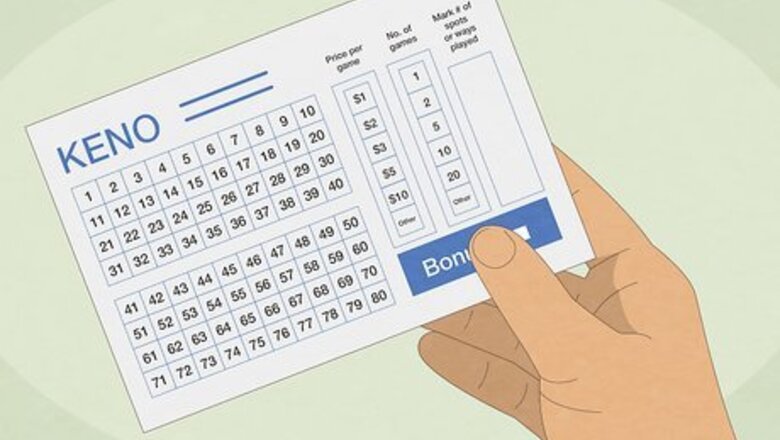
views
- To begin a keno game, fill out a keno card by betting on numbers (or keno spots) that you think will be randomly selected. Try to guess as many out of 10 as possible.
- Buy “way” keno cards if you want to bet on groups of numbers as well as individual spots. If you match multiple numbers in your group, you earn more money.
- To increase your jackpot, bet on additional bonus numbers. Bonus numbers cost additional money to wager, but offer a higher payout percentage if selected.
- Join keno games with lots of people. The payout for each game is determined by the number of players.
Mastering the Basics

Acquire a keno card. To play keno, fill out a card with the various numbers you want to place your bets on. Cards are generally found at specified keno lounges in casinos. If you’re playing online, a keno card will automatically be shown on your screen after you log into a game. The numbers on the card (1 through 80) match the numbers on the balls in the aerated keno machine. Some casinos may use a randomized computer to select winning keno numbers instead of drawing balls from a machine. All online keno games use this method as well. Certain lotteries have different versions of keno cards. Some have special bonus or “jackpot” cards available, in addition to their regular cards. Ask if more than one type of keno card is available.
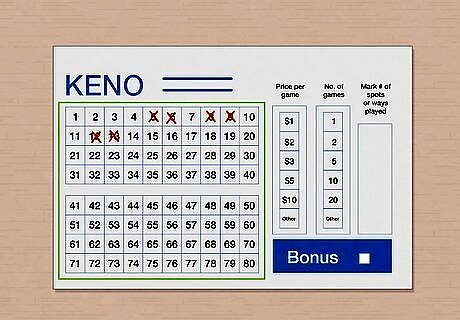
Select your keno numbers and mark them on your keno card. Once you’ve gotten a keno card, begin writing down or filling out the numbers you wish to bet on. Each number you select is called a keno spot. Your keno card is arranged with 8 rows and 10 columns of keno spots. The card will specify how many numbers you're allowed to choose. Some cards will allow you to choose anywhere from 1 to 10 numbers, while others will say anything up to 20 is okay. The ticket costs the same amount either way, so it’s in your best interest to choose as many different numbers as possible. Some cards will have a "quick pick" section where you can have a computer randomize your selections for you. Your odds of winning remain the same regardless of how you choose to fill out your numbers. Some keno results boards will display “hot numbers” and “cold numbers.” Hot numbers are numbers that are selected often, while cold numbers are numbers that haven’t appeared recently. Don’t fall for the trap of using these numbers to determine your choices! Since the system is random, every number has an equal opportunity of being selected, regardless of previous results.
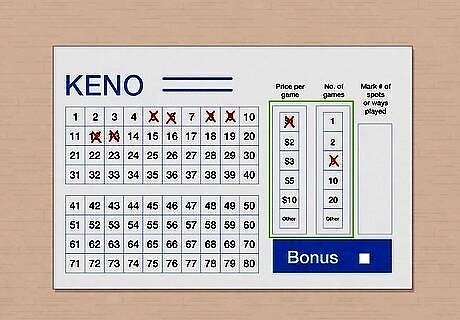
Choose your betting amount and how many games you want to play. Each keno card offers you the choice to play multiple games with the same numbers. In addition, you can multiply your betting amount to increase your winning total if your spots are selected. (For example, you can bet $2 instead of $1 to receive double the payout, $3 to receive triple, and so on.) Make your decisions and indicate your choices on your keno card. If you bet $1 on your selected numbers and want to play 7 games, that'll cost $7. If you double your bet, it’ll cost $14, and so on. However, you cannot vary your betting amounts on the same card. (For example, you couldn’t select 7 games, bet $1 on the first, $4 on the second, $3 on the third, etc.) You can wager as little as $1 on a single bet and usually up to $20. However, the betting amount varies on the location hosting the keno game. Start betting small and set a predetermined budget before playing any keno games. You'll have more fun if you play responsibly.
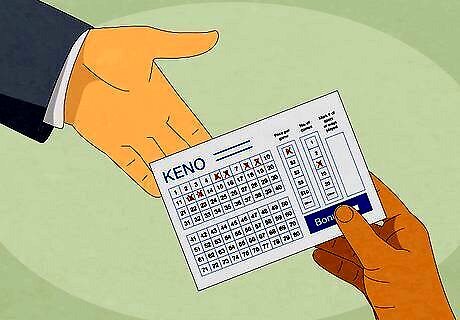
Hand your keno card to a keno worker. Once you’ve selected your keno numbers, hand your keno card to an official who will factor your chosen spots into the next game. An electronic copy of your card will be issued back to you so that you can follow along as numbers are announced. Double-check your choices to ensure that everything is correct before handing your card over. If you selected “quick pick,” your electronic copy will show you what numbers the computer randomly selected for you.
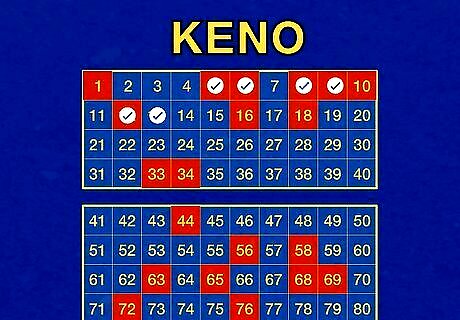
Wait for the keno machine to determine the results. Keep your eyes on the electronic keno boards throughout your venue to see the results of your keno games. The number of the game you're playing will appear somewhere on your ticket and on the screen (usually in the bottom corner). Once you’ve found a board displaying the results of your game, match the numbers on your ticket to the numbers on the screen. If you have a match, you win! How much money you win will depend on how many numbers you matched and how much you wagered. Most keno boards will display the payout for each number of spots matched. Your payout depends on the number of keno tickets in each game. In some instances, a single dollar can net a payoff of tens of thousands. Ask a keno worker for an explanation if you're unsure. Some keno parlors also utilize a special payoff for selecting a bonus number. Every house is different; there is no average payout. However, most payouts tend to range from below 70% to around 80%. You want your payout to be as close to 100% as possible.

Declare your winnings. If you have a winning number (or numbers), call a keno worker over to receive your payout. Or, bring your ticket to any keno retailer in your area. Then, submit an electronic keno card to verify your matches and collect your payout. After you’ve collected your winnings from one game, play another. Games are usually played in 4-minute intervals. That's the best part about keno is it's constantly going non-stop.
Betting on Combinations
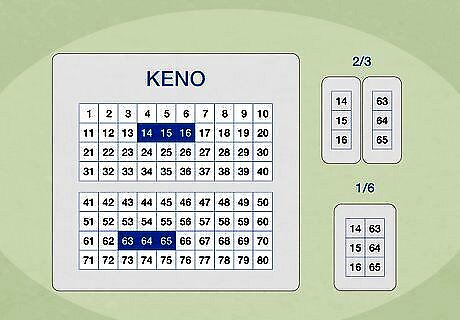
Use a "way" ticket to bet on combinations as well as individual numbers. Ask a keno worker for a special “way” ticket, which will allow you to bet on various number sequences. For example, you might choose 6 numbers. Circle these six numbers in 2 groups of 3. Then, on the side of the ticket, mark "2/3" and "1/6." This means you want to bet $3. $1 is on one group of 3, $1 is on the second group of 3, and $1 is on all 6. You’ll receive higher payouts if all the numbers in your group are selected. Each number combination requires an additional wager. You can select as many combinations as you want from your selected numbers. You could split 18 numbers into 9 groups of 2, 3 groups of 6, or anything in between. However, experts advise grouping numbers in 3s and 4s for the best chances of winning. Think of way tickets like horse racing. Hitting the winner is good; hitting win, place, and show is even better.

Bet on overlapping number combinations as well as separate sets. Use the same numbers in multiple combinations to increase your likelihood of matching. For example, let's say you have a group of 2, a group of 3, and a group of 4. Combine these groups together by creating a group of 5 (3 and 2), a group of 6 (2 and 4), a group of 7 (3 and 4), and a group of 9 (all the numbers). For $1 per group, this would cost $7 with 7 potential payout structures. Some way tickets allow you to bet 50 cents on groups instead of $1 for half the original payout. There is no evidence that certain overlapping number combinations are more likely to hit than others. Results are completely random each time. However, the larger your combination is, the less likely you are to match the entire set.
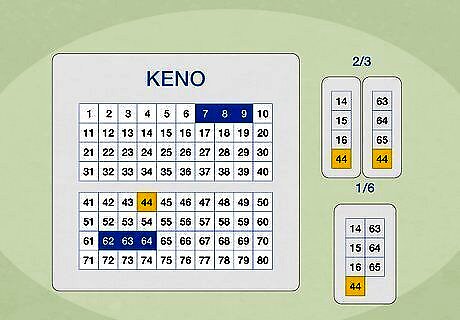
Add a "king" to your number combinations if you’re feeling adventurous. When a number is circled all by its lonesome, it is "king." You can insert individual, disparate numbers you bet on (kings) into other sequential number combinations. Let's take that first example of 2/3 and 1/6. Suppose the groups you bet on are 7, 8, 9, and 62, 63, 64. Add a king (in this case, a number 6 or lower, between 11 and 60, or above 64) on top of these combinations to create 2/4 and 2/7. Since the king has now joined each group of three, it is added to the final total, creating 7 spots instead of 6. To specify that a number is king, simply label it on your card and draw an arrow to the group of numbers you wish to add it to.
Keno Variations

Make an additional wager on the bonus for a higher payout. Many state lotteries or casinos have some type of bonus for all keno games. To bet on a bonus, select a specific additional number and bet extra on that bonus number. (The extra cost can be anywhere from $1 to double your wager.) If this number is selected, you’ll win big. Sometimes, the bonus is called a bull's eye, sometimes a booster, sometimes just a bonus. But you’ll know it when you see it. The bonus payout varies. It can be anywhere from double the winnings to 20x the normal rate. Ask the keno worker at your station how your specific venue’s bonus works.
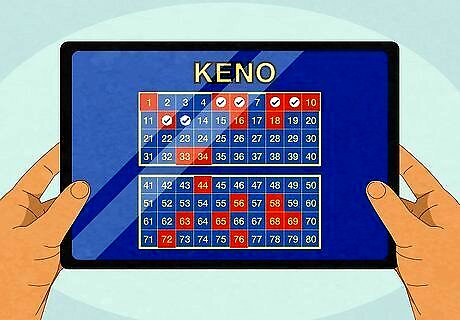
Play keno online or in video form instead of face-to-face. Some casinos offer keno via touch screens instead of in-person, and some keno games can be played completely online. While the payout for online games tends to be higher, the gameplay is much faster. Meanwhile, video keno allows you to play at your own pace, but the payouts are less impressive. Decide what game is best for you. Some video keno games require only penny or nickel bets. Check what your minimum bet is before you begin a game.
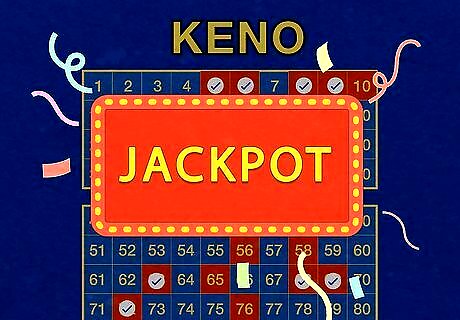
Keep the progressive jackpot in mind when betting. Many casinos offer a progressive jackpot. In a progressive jackpot, if no one hits it big, the payout keeps growing and growing until someone matches. Many progressive jackpots have reached well over 100% of the betting value! One of the best strategies to succeed at keno is to join a game after the progressive jackpot has already increased a few times. This way, you get a much higher value for your wager.
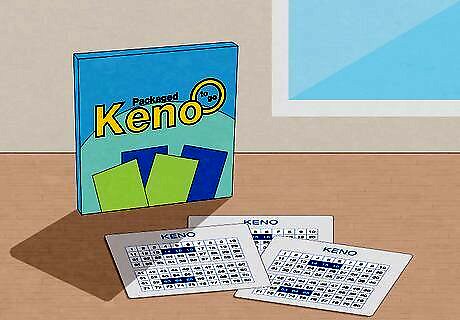
Try packaged keno when purchasing your tickets. Similar to "buying in bulk," play “packaged keno” to bet on more games at a lower price (usually around 25 to 50¢ instead of $1). Packaged keno games allow you to play your keno cards whenever you want (sometimes even from the comfort of your own home), as long as you give your ticket to a keno retailer beforehand. Packaged keno is only offered in select casinos and apps. Talk to a keno worker at your local venue for more information.












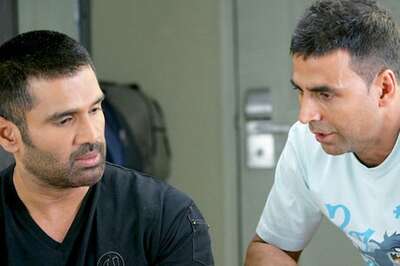






Comments
0 comment